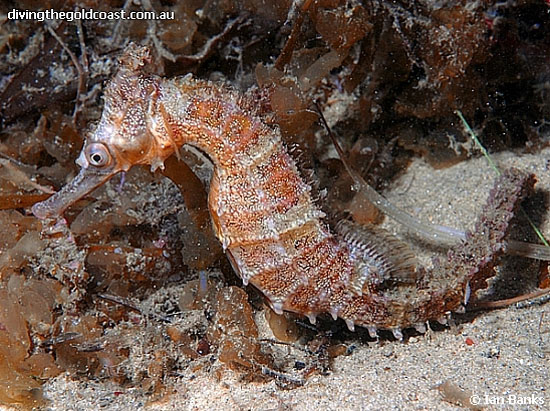| Syngnathidae (Pipefishes and seahorses), subfamily: Syngnathinae |
| 13 cm OT (male/unsexed); 11 cm OT (female); max. reported age: 5 years |
|
demersal; brackish; marine; depth range 0 - 46 m, non-migratory |
| Southwest Pacific: Australia. |
|
Dorsal soft rays (total): 17-18. This species is distinguished from its congeners by the following set of characters: trunk rings 11; tail rings 34-35; dorsal fin rays 17-18; pectoral fin rays 16; subdorsal rings 3; subdorsal spines 4, superior trunk ridge ending with 3 enlarged spines, the superior tail ridge commencing with one enlarged spine (3/0,1,0); cleithral ring spines 3, one small spine at each end of pectoral-fin base, none at gill-opening, large single or double spine at ventral extent of head; with 2 small lateral head spines, one directly posterior of eye, one anterodorsally of operculum and ventral of coronet; with a distinct snout spine; no parietal spine or diminutive if present; single eye spine, large and protruding dorsally; small single or double spine, rugose, posteroventrally of eye; the coronet, distinct and tall, protruding anteriorly in juveniles, angled
dorsoposteriorly in adults, and with 5 small spines present on apex in a star-like arrangement;
superior trunk with enlarged spines on first and eigth tail ridges (Ref. 125503). |
| Occur in coastal estuaries and embayments (Ref. 125503); in shallow, weedy inshore areas and Zostera seagrass beds; also on sponges. Also under jetties on holdfasts of kelp, and on other man-made structures such as shark nets. Diurnal and site faithful (Ref. 30915). Female max length (Ref. 42735). Ovoviviparous (Ref. 205). The male carries the eggs in a brood pouch which is found under the tail (Ref. 205). Minimum depth reported taken from Ref. 128812. |
|
Endangered (EN); Date assessed: 05 October 2016 (A2bc) Ref. (130435)
|
| harmless |
Source and more info: www.fishbase.org. For personal, classroom, and other internal use only. Not for publication.
